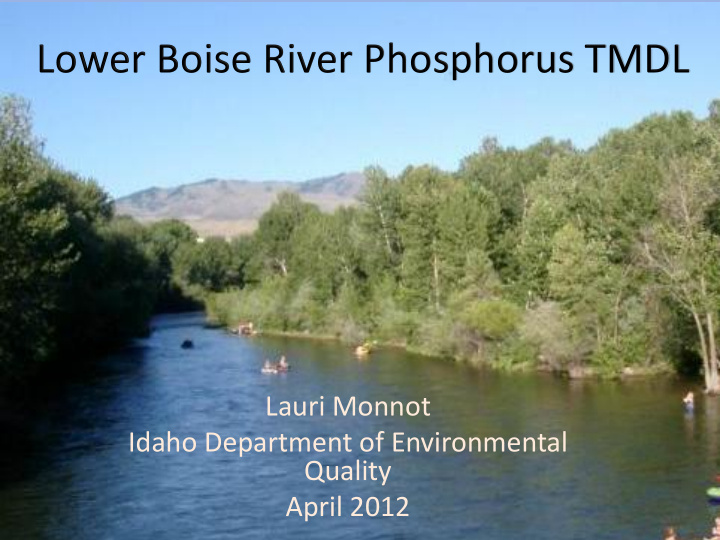



Lower Boise River Phosphorus TMDL Lauri Monnot Idaho Department of Environmental Quality April 2012
Basics of Phosphorus and Phosphorus Pollution
Phosphorus in Nature
Nutrient Spiraling Aquatic Plants Dissolved Nutrients (luxury consumption) (orthophosphate) Plants Die River Water Bottom Column Sediment Uptake by Rooted Plants
Phosphorus in the Boise River Where does it come from? – Point Sources – WWTF – Nonpoint sources » Municipal wastewater – Agricultural » Industry – Septic systems » Hatcheries – Stormwater – Groundwater – Background – Natural weathering – Biological processes
Phosphorus Load (2008 IP)
Phosphorus Standards
Water Quality Standards (WQS) • Rules developed by states to define how much of a pollutant can be present without impairment of beneficial uses IDAPA 58 TITLE 01 CHAPTER 02 58.01.02 - WATER QUALITY STANDARDS
WQS Types • Numeric criteria - defines a number or concentration for a pollutant – Simple WQ target definition • Narrative criteria – free from…. – Flexible, assimilative capacity differs
States with Numeric Nutrient Criteria
Nutrient WQS is Narrative for Idaho • Surface waters of the state shall be free from excess nutrients that can cause visible slime growths or other nuisance aquatic growths impairing designated beneficial uses (IDAPA 16.01.02.200.06).
What Do the Data Say?
1999 Lower Boise SBA Conclusions • TP concentrations during the growing season at Middleton and Parma are more than sufficient to support algae growth • DO % saturation rarely below WQS • DO concentration always met or exceeded 6.0 mg/l • Water column Chl- a data do not indicate excessive growth of algae • Periphytic Chl- a exceed suggested nuisance thresholds but there was an absence of DO problems • High sediment concentrations in the river below Caldwell may preventing algae growth Status Summary- Data do not show major impairment of beneficial uses due to nutrients and associated nuisance aquatic growths. However, high nutrient concentrations and periphytic algae levels imply that nutrients are a potential threat to aquatic life and recreational uses.
Lower Boise River Implementation Plan 2008 • SR-HC TMDL (2004) load allocation 0.07 mg/l TP for all tributaries to achieve beneficial uses • Plan to meet the Boise River target at Parma for SR-HC TMDL – Gathered available data (post 1999 SBA) – Pollutant source inventory – Developed load allocations to reach target
LBR Nutrient Impairment • 2008 Integrated Report DEQ proposed to de- list for nutrients – 1999 SBA supports de-listing • EPA denied delisting - comments on delisting proposal for 2008 IR – http://www.deq.idaho.gov/media/773615-2008- ir-epa-response-lower-boise-river-hem-creek- 101309.pdf
Reminder • Surface waters of the state shall be free from excess nutrients that can cause visible slime growths or other nuisance aquatic growths impairing designated beneficial uses (IDAPA 16.01.02.200.06). • Boise River does not meet this standard – Proceed with TMDL
Lower Boise River Phosphorus TMDL Questions?
Recommend
More recommend